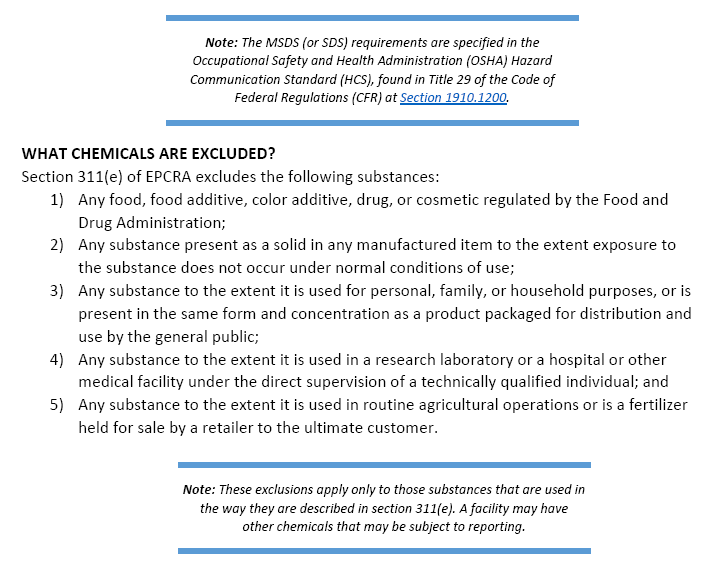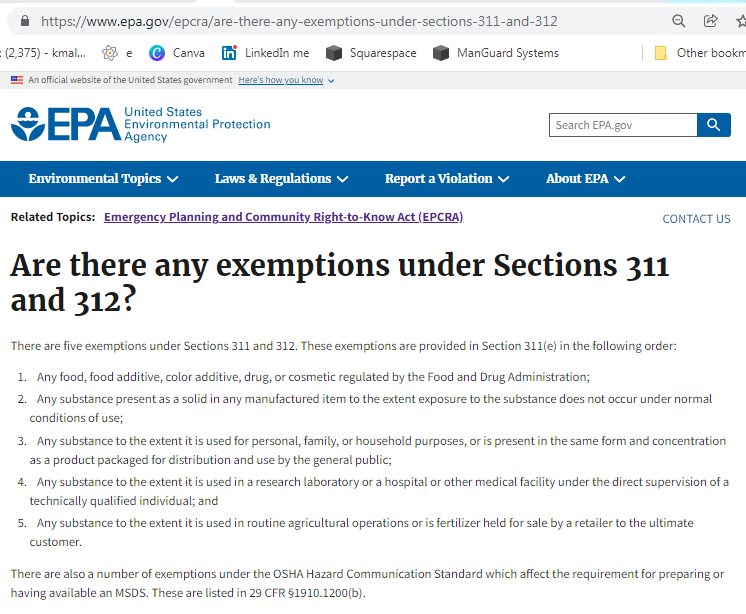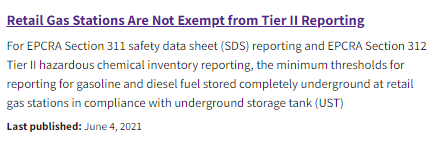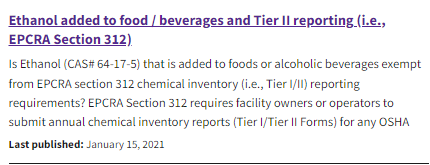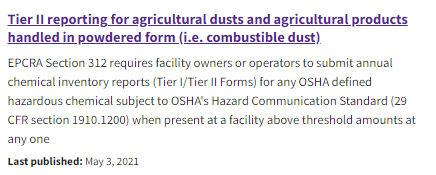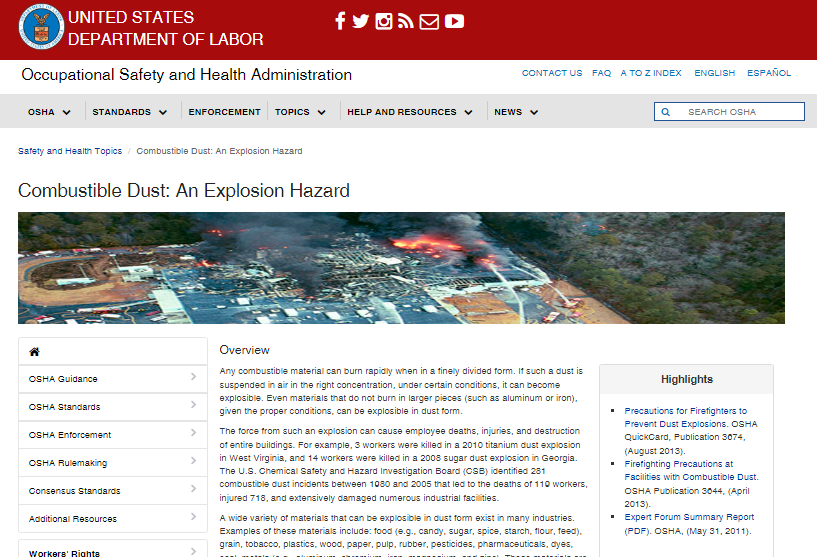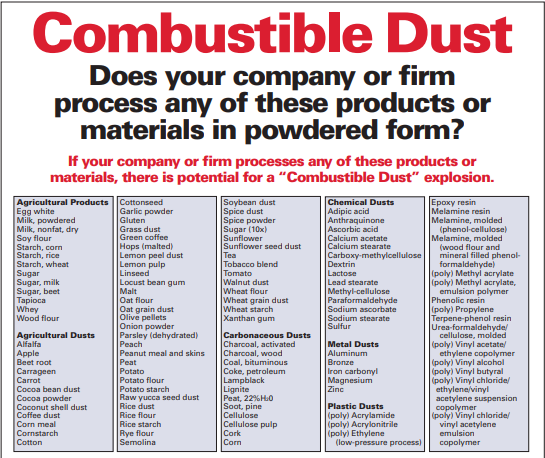29 Days: Exemptions, Part 1 of 2
If you didn’t exceed Thresholds in the previous Threshold Determination step you might not even want to bother with these…(but it’s interesting reading…if you’re a geek)
And there are 2 parts to this question:
1) exempting the exempt materials from Threshold Determination calculations. Probably only worth bothering with if it might make a difference in whether a material is reportable or not and 2) whether you need to include this material on your Tier2 report if you exceeded EHS thresholds using the non-exempt materials
Summary of Exemption information from the RY 2021 Instruction Booklet
Here’s a link to the same information on the EPA FAQ website:
Pretty much the same wording…
When I searched the EPA FAQ for “Tier Exemption Threshold”, I got 9 entries, the last 3 of which deal with batteries and are probably the most relevant. I’ll review just the first 4 of these today (I try not to have posts quite this long)
But some seriously interesting trivia in some of these, and some hidden gems about other topics not obvious from the title of the FAQ (again, I’m a geek)
Interesting reference in this one: “a farm that uses gasoline or diesel fuel to run farm machinery may be eligible for the exemption for a substance to the extent it is used in routine agricultural operations (EPCRA section 311(e)(5), 40 CFR 370.13(c)(3)).”
This one is just serious trivia. Who knew that Ethanol is added to pizza crusts and the fillings for croissants? Which makes the ethanol (which a Generally Recognized as Safe (GRAS) additive) regulated by FDA and so exempt from Tier2..
What I didn’t anticipate was the following “Ethyl alcohol produced in the manufacture of beer, wine, and distilled spirits is under the purview of Alcohol and Tobacco Tax and Trade Bureau and not FDA”. And since it says “produced in the manufacture of” does that mean the alcohol naturally created by fermentation needs to be included? This is not one that I have experience with…
This one is a nother example of how only the exact CAS Number that appears on the Extremely Hazardous Substance list is an EHS. (We had examples of this on Days 32 and 33 for Phenol and Sulfuric Acid)
A chemical that contains the EHS chemical (Ammonia) but for which the compound (Ammonium Hydroxide in the EPA example) has its own CAS Number is only subject to the Hazardous Substance (has an SDS) Reportable by Amount threshold of 10,000 pounds (or your local equivalent), not the Extremely Hazardous Substance EHS threshold, which would be lower..
Tier II reporting for agricultural dusts and agricultural products handled in powdered form (i.e. combustible dust)
This one points you in the direction of several other resources, and encourages you to include it on your Tier2 report with the “Below Reporting Threshold” checkbox checked so that your Fire Department and Local Emergency Planning Commission LEPC know this potential hazard exists at your site.
OSHA combustible dust website link
More tomorrow, here’s to March 2nd!
More tomorrow, here’s to March 2nd!
Community outreach: Which of these exemptions do you use and in what way?
#SARA312 #SARATierII #SARATier2 #EPCRA #EGLE #March1EPAReportDeadline #ThresholdDeterminations #ExtremelyHazardousSubstances #EHS #ThresholdPlanningQuanitity #TPQ #exemptions #agriculturalexemption #foodexemption #laboratoryexemption #articleexemption #personaluseexemption
Michigan Environment, Great Lakes, and Energy EGLE links from all three 2022 SARA 312 virtual training course webinars:
I’m reposting these links with my daily Tier2 post because they are so useful.
You can sign in and watch/listen even if you didn’t sign up for the webinar series.
RECORDING LINK FOR SESSION 2: Wed Jan 19, 2022.
Really good example on batteries. This is the “in the weeds” how to conduct your threshold determinations episode: https://attendee.gotowebinar.com/recording/4027906237723673347
I talked to Mike Young, one of the presenters, right after the first webinar. He said that it’s not unusual for them to take phone calls from people from other states (with the warning to confirm that your state doesn’t have differences in their requirements compared to Michigan).
RECORDING LINK FOR SESSION 1:
https://attendee.gotowebinar.com/recording/7957790593170499843
Michigan uses Tier2 Manager for report submission, which is a Michigan-specific program. If your state uses different software, you will need to review its specific requirements.
RECORDING LINK FOR SESSION 3:
https://attendee.gotowebinar.com/recording/2763075340284995085
If your state uses a different software program there may be some differences, but this webinar will probably also cover how to determine the Hazard Ratings, how to enter Locations, and other details associated with report submission. I’ll post the replay when it becomes available.
PRESENTATION: (I wasn’t able to attach a copy of the presentation, email the link below and they will send it to you)
SARA TITLE III – TIER II REPORTING WEBSITE: http://www.michigan.gov/sara
MICHIGAN FACILITIES’ GUIDE TO SARA TITLE III: https://www.michigan.gov/documents/deq/deq-oea-saraguidebook_509720_7.pdf
CONTACT INFORMATION:
Mike Young and Adam Pohl
517-284-7272
